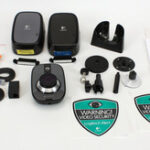Stereoscopic 3D, also known as “True 3D”, is the stunning illusion of giving an individual the perception of depth in using what would commonly be seen as traditional two-dimensional, or “flat”, visual media.
Imagine how a video camera works, in that it captures a visual signal and outputs it to a monitor, such as your television screen. Now, imagine two video cameras that are very close together, the same distance apart from one another as the distance between the eyes on your face. Instead of displaying a single frame or sequence of frames from a single visual output to a person like a camera would normally do, two sequences of frames are captured from the combined cameras, one signal for each your left and right eye, and in sending these visual signals to each respected eye, Stereoscopic 3D, the illusion of depth, is achieved.
True 3D isn’t limited to the use of physical video recorders for live action media. In fact, it’s more prominent in the industry of computer generated films, especially ones presented by major motion picture studios, Pixar and Dreamworks. Stereoscopic 3D is growing rapidly, becoming more widely used in major films, and even being presented within the world of video games.
The demand for Stereoscopic 3D capable media is wildly increasing. Motion pictures that advertise a theatrical release of a film that features True 3D have reported generating as much as three times the revenue of it’s otherwise identical 2D counterpart. Stereoscopic 3D is a media feature that’s been around for many years, though was never widely known due to the lack of 3D content, which was much the fault of there being no high quality equipment that could output Stereoscopic 3D images, and no way for the everyday consumer to experience True 3D at an affordable price.
Because of the increasing demand for Stereoscopic 3D media, several corporations are capitalizing by taking the initiative to more openly support and provide content for the rapidly expanding market. Sony has even recently announced that in the year 2010, it will be releasing a Sony Bravia LCD HD television that will be capable of outputting Stereoscopic 3D video, further stating that the Sony Playstation 3 console will receive an online update around the same time that will allow Playstation 3 games to be played in Stereoscopic 3D as well. Sony went on to announce that all games should technically be compatible to feature True 3D, though will be at the discretion of the game’s original developers. Showcased here is the Playstation 3 exclusive title, “Wipeout HD”, being played in Stereoscopic 3D, and provided here is a look into what other games may be supporting Stereoscopic 3D on the Playstation 3 console as well.
Unfortunately, if you were to obtain a source that’s capable of outputting Stereoscopic 3D content, it doesn’t mean you have the benefit of actually viewing the display properly. Stereoscopic 3D compatible monitors most commonly provide the viewer with True 3D visuals by interlacing or overlapping the two video outputs on the same display unit. What this means is that when looking directly into the monitor, it will likely appear to be a confusing mesh of blurred video. Because of this, wearable devices known as “LCD Shutter Glasses” are often provided with these display units, which will output the visuals to your eyes in their intended format.
~ LCD Shutter Glasses ~
LCD shutter glasses should not to be mistaken with the cheap, flimsy “Anaglyph Glasses” of old, which use red and blue (red and cyan, if you’re technical) lenses to fake a 3D image to the viewer, and are of noticeable inferior quality in comparison.
Liquid crystal display shutter glasses, or LCD shutter glasses, use the liquid crystal within the frames of the glasses to either allow light to pass through to the eye of the wearer, or to block the light from being seen. The use of these glasses is that they synchronize with your Stereoscopic 3D display monitor to separate the images from appearing as a conjoined mess, and showing only the right images to the right eye, and the left images to the left eye.
For example, let’s say you have a HD Stereoscopic 3D television with a refresh rate of 120hz… For those don’t know, “hz” or “hertz” represents the number of times your television refreshes in the time of one second. To further simplify, you can also think of it as the maximum frames per second of your monitor… This means that when projecting content that’s True 3D, each set of images, the left and the right, will only display their respective footage every other frame.
So content for the left eye will display on frames 01, 03, 05, 07, 09, 11, 13… all the way up until it reaches 120, then it starts all over again.
Likewise, content for the right eye will display on frames 02, 04, 06, 08, 10, 12, 14… all the way up until it reaches 120, then it too will start all over again.
This process is so fast that if you were to watch the screen without the LCD shutter glasses, it would just look like two sets of images overlapping in a big visual mess. Wearing the LCD shutter glasses will sort the images and channel them into which eye they’re meant to be seen by. Just as images for the left eye will only be displayed for frames 01, 03, 05, 07… the LCD shutter glasses will allow the images to be seen by only the left eye for those respective frames, while simultaneously blocking the right eye from receiving the same image. The same process applies for images that are displayed from your Stereoscopic 3D monitor that are intended for your right eye, and not for the left.
Thanks for reading, and I hope this guide has given you a better understanding of the processes used to create and display Stereoscopic 3D content.






